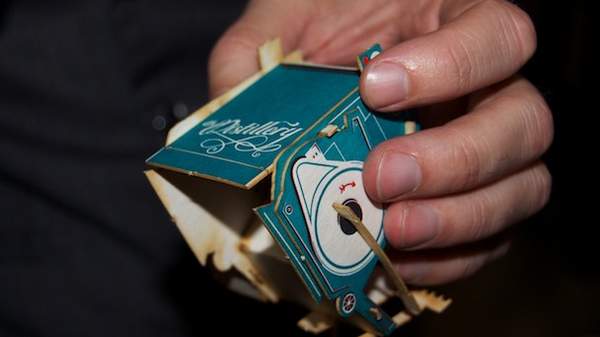Overview
Objects: The Beehive
"In terms of dental prosthetics, printing's been used for a long, long time. That's where it all really developed." says the Beehive's Adam Long. 3D printing — formally known as additive printing — and laser-cutting are the province of the Beehive, a Gladesville outfit that shares space next to an expansive mechanic's garage with the Robots and Dinosaurs (a local hackerspace). Adam is one third of the Beehive, along with Daniel Almagor and Daniel Sutherland.
They say they founded the Beehive almost in reaction to design school. "Why make a million things the same, when we can make one million, customised. The other element we wanted to bring to it was sustainability, the complete opposite of everything we were taught at university, essentially."
3D printers can print pretty much anything you can squirt out of a tube or whose powdered form can be melted. In theory, it's sustainable from "cradle-to-cradle" — unwanted printed things can just be melted down and printed again at "equal or higher quality." And you really can print almost anything: steel, paper, cardboard, plastics or even chocolate.
The Beehive makes consumer products, like notebooks, and are moving into corporate gifts. When we met them, they had been planning to move into printing designer glasses as well. Getting the plastics in the glasses just right for someone's prescription lenses is usually tricky, but a 3D printer can just melt down a bad prototype and print it out again until it fits right.
Their laser-cutter can also come up with surprisingly three dimensional products, either assembling cut pieces like a model kit, or burning through thicker materials to give the illusion of solidity.
And laser-cutters can also cut into a surprising number of things. Toast, for example.
"We've done bread on there, and engraved a pattern into that." says Daniel Sutherland. "You could've eaten it. I had a bite. It wasn't any good." They mention other places that are doing tattoos with laser-cutters, seaweed for sushi and even burning some designs onto fingernails, engraving away nail polish to make patterns.
"You have to line up fingers perfectly, on that."
The Beehive makes and engraves a lot of wooden products with theirs, but are comfortable cutting out perspex jewellery as well. For some local artists, this process means they can get an order for a piece jewellery, then print it and post it to their customer. It's like an accelerated form of "just in time" manufacturing. At the moment they're also running an (already successful) Kickstarter campaign to produce a line of customised, sustainable, bamboo notebooks.
The Beehive's laser-cutter uses a high-powered laser that runs at 100 watts — the same as many incandescent lightbulbs. A massive laser tube in the back of the machine bounces a beam off a series of mirrors until it reaches nozzle at end, where a lens focuses it down to the size of a pinprick. And all this energy punches right through timber, plastic or paper.
Artists wanting to use the laser-cutter send a design off to the Beehive, be it a hand sketch or computer file. Translated in the computer, it becomes series a series of mathematical lines (vectors) that get translated into a machine code, telling the laser where it needs to cut.
"Then you pretty much just hit go." says Long. And assuming the first one comes out ok, that's about it.
For 3D printing there are two main types of printer; selective laser melting uses a laser to melt tiny layers of powdered plastic or metal into a solid object, and fused deposition modeling uses a moving nozzle, squeezing out plastics melted from long, white loops of plastic string (or chocolate) in an endless sausage, snaking out the layers of the object from bottom to top.
They're still tricky to operate. Daniel says the designs at the moment "aren't focusing on usability. They're focusing on resolution." It took us a while to get something decent to come out, says Long. "It took us a while for something decent to come out. I'd say the learning curve was about six months."
He adds: "They're about as useable as a PC was in 1981."
With this technology you can make locally for the same cost as you could in China. When the machines are doing all the work, it doesn't matter where that machine is. What we're really excited about seeing in the future is that everything gets made local, custom and from sustainable materials."
One of the first things they made themselves with their first printer was second 3D printer. This is an ongoing theme with 3D printing, the dream of a printer printed entirely by another printer. The technology isn't there yet to print a whole machine, but you can print a reprap — a hybrid machine with some printed and some made parts.
This second printer cost them about $500 to make. In the photo below, the white parts of the machine were printed. Printing circuit boards, though, is still a bit of a dream. Although it keeps on getting closer.
"Anyone can join up to a [hackerspace] like this and have access to all this kind of equipment." says Long. "It's like, you know those videos you'd see before DVDs: You wouldn't steal a handbag, you wouldn't steal a car. Well, you know, if you could print one, you might actually steal a car. If you could download a Ferrari and print one at home? Yeah, yeah. I'd probably steal one."
